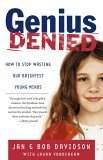
![]() Welcome to Our World: The Visual
Spatial
Welcome to Our World: The Visual
Spatial
When
we first started homeschooling in 1999, I knew that my student was gifted
and really thought it was going to be such an easy journey. Our first
few months we used a purchased curriculum from one of the well known
"homeschool friendly" curriculum providers. My student literally
"sucked" that dry in a few months and was looking for more.
I had pulled him from a private school that was well known for academics
because he wasn't being challenged enough. I didn't want a repeat of
that in our homeschool so we took a trip to Florida when we reached
the end of all the books this purveyor of knowledge had sent as a "school
year". While on this trip, I realized that my student really had
a different way of absorbing ideas and had an intense memory for the
obtuse details. Talents I didn't have, but I admired. When we returned
from our trip I "winged it" for the rest of that "school
year" using videos and trips to the library and museums. What I
found from this experiment was that my student, for lack of a better
description, saw most things in pictures and diagrams and learned things
from pictures and diagrams where I saw the world as an ordered place
and ran my life with lists and post-it notes.
It was over that summer I read two books: Multiple
Intelligences: The Theory in Practice & Frames
of Mind: The Theory of Multiple Intelligences. both by
Dr. Howard Gardner of Harvard University. These were very enlightening
to me. I had read all the "gifted books" I could lay my hands
on at the time and not one touched on the ideas Dr. Gardener had. Even
if an author had tied the words "gifted and multiple intelligences"
together, it would have been a help in our situation. I tried to use
as often as I could, really visual resources in our learning experiences.
Still, my student and I locked horns for the next three and a half years
over what I saw as the simplest tasks. Multiplication tables from flash
cards was a nightmare for both of us. They are visual right? But I could
only try to impart the "stuff" I thought my student needed
to know in the way I learned it....I read more books on how kids learned
through those three years, In
Their Own Way: Discovering and Encouraging Your Child's Multiple Intelligences
and In
Their Own Way by Thomas Armstrong were really good at helping
me to eventually realize that "child led" learning was really
the best way to go for us. It wasn't until I stumbled onto a website
in Denver that I found a pretty good description of my student:
| Visual-spatial
learners think in pictures rather than in words. They learn
better visually than auditorally. by Linda Kreger Silverman |
At that point, I had my "label" and I could find all the good ways to bring the world to my student. There aren't many books written about the visual spatial learner, but after spending the last 8 years exploring the world with one, I "get" what homeschooling a visual spatial is all about. I can even write stuff now that makes me sound like an expert, though I know I am only an expert on how my student is. But because of the path I took,
 |
 |
 |
 |
 |
©
2005-2022. Bright Kids at Home LLC. All
Rights Reserved.
|
